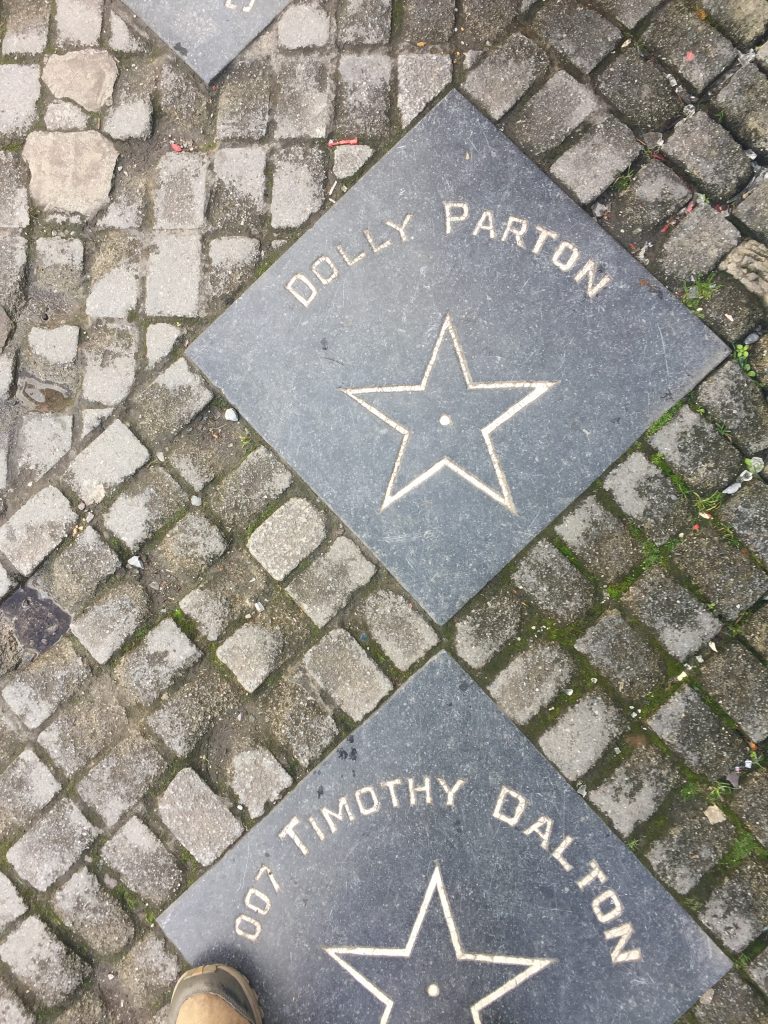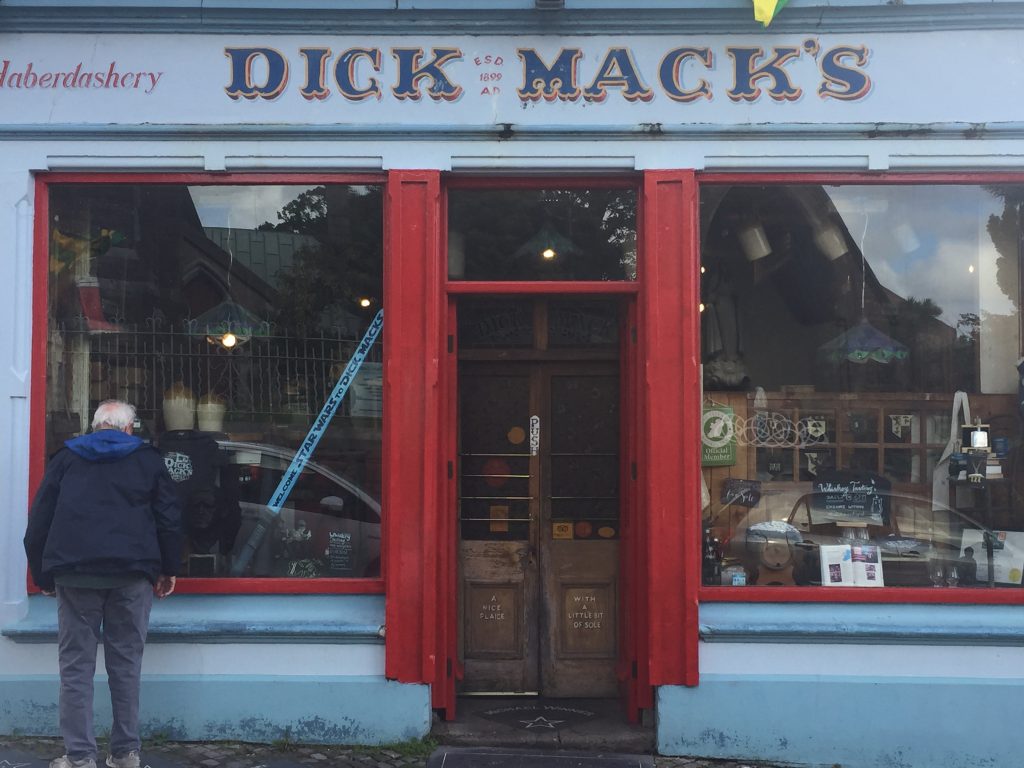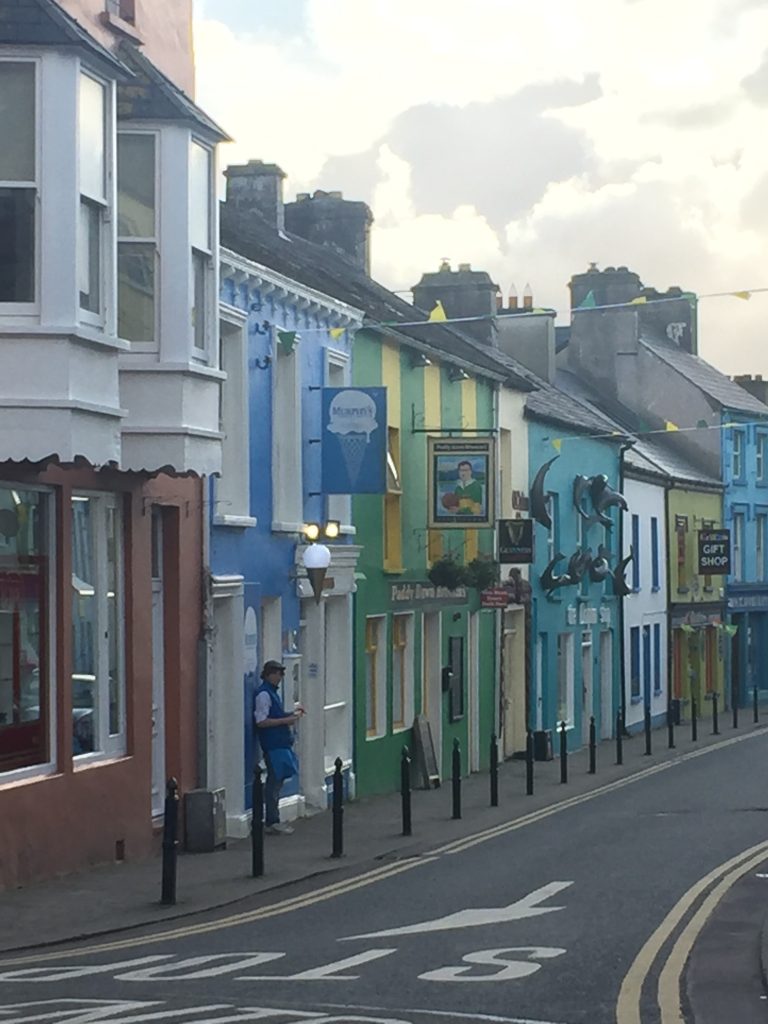
Dingle Pubs
Dingle seems to have lost much of its charm since I last visited over twenty years ago. The throng of tourists, the number of shops selling Oirish produce, the overpriced food, and the diddly-ay blasting from every pub leaves me feeling somewhat nauseated. However, two of the pubs on my list are here, so we have no choice but to pay them a visit.

In the early evening sunshine, we stroll up to Dick Mack’s, where a feast of famous musicians has loosened their vocal chords and struck up a note. This is the pub where Dolly Parton famously sang her ‘coat of many colours’ (look it up on YouTube!) but it’s evident from the series of stars on the pavement outside that she’s not the only one who thought it worthy of popping by. Nor is it only musicians who call in – there are several actors too, and the infamous politician and Taoiseach Charlie Haughey, who spent a lot of time in Dingle where he moored his boat. We open the door into the pub and squeeze by the crowds lining the bar. There is a couple singing in one corner and all assembled are seemingly entranced by the cover of a Van Morrison song being belted out. Everyone faces the musicians and in their well-established groups, they clap and sing along. We manage to catch the bar man’s eye, order drinks and shuffle sidewise out of the main bar into a side room, where we get seats.
Maybe I’m older or crankier than I care to admit, or perhaps it’s just too early in the day for me (although that would be a first), but Dick Mack’s holds no attraction for me. There isn’t a hope of actually having a conversation with anyone here, not only because they are all too busy watching a fairly mediocre version of well-worn songs being trotted out, but also because it’s apparent that the bar is crowded with people who’ve come together – groups of friends, and several multi-generational families. They are here to socialise with each other, not engage with strangers, and I know from experience it’s almost impossible to penetrate these collectives. Most disappointing of all however, is that it’s very clear that there’s not a single local here, apart from the three men behind the bar, and possibly the musicians. We may as well be in the Arlington Hotel on Dublin’s Quays, with coach loads of American tourists trying to reclaim their Irish heritage and watching bad versions of River Dance. We quickly down our pints and get the hell out of dodge.

We ramble up the street, heading towards the second Dingle pub that features in Turtle Bunbury’s book ‘The Irish Pub’. (Yes, that really is his name). I’ve recently been negligent of my all-Ireland pub tour based on his book and the subsequent TV documentary, but I’m determined to catch up.
At the top of the gentle hill, and a little beyond the frenetic hub of activity in the main village, Currens’ sits on a long street of shops and houses. It’s a road we’ve all seen many times on postcards and images of traditional Ireland, each front painted a different bright colour, and the terraced buildings sloping down the hill to the sea.

Pushing the doors open, we walk into a bright, open, square space, the bar running down one side, and the walls covered in memorabilia, photographs, old tickets and posters. We get seats at the bar, beside a young man drinking his pint and reading the paper and an older man who is chatting with the bar man. I am home.
We are immediately drawn into conversation with Johnny the bar man, and the younger man, who coaches the local football team that his seven-year-old plays on. We talk about the weather and where we’ve been, where we’re heading, what kind of season they’ve had here, and then I mention the book, and we’re off!

Johnny was here when they filmed the documentary, and also remembers Turtle coming to do the interview for the book. He refused to be on camera. ‘Who’d want to be looking at me?’ he asks.
He wants to hear which other pubs we’ve been to, which ones we like, which disappointed, and of course, what our views on Currans’ are. I tell him he’s the highlight so far.
He regales us with stories of people who’ve visited on foot of seeing the documentary and is especially impressed by a group of 14 American women who arrived in Dublin, hired a bus and toured the country visiting all 30 pubs in the book. I’m jealous.
We talk to a man from Doolin who visits regularly; we tell him we were there just a few months back and he’s glad to know we enjoyed his home place. ‘Mind you’ he says ‘I’m not sure I like the way the place is going. I mean, what do we need an ice cream shop for in Miltown Malbay? Never mind one with a feckin queue!’
Behind us, sitting at a high round table, there’s a group of four women, in their late sixties, or possibly seventies, drinking gin and tonics. They are well spoken, well dressed and appear pretty affluent; they aren’t typical country people, but I gather they are local, living in the area at least part of the year. Horsy people, who talk a lot about new buys and how the training is going, but also about books and holidays, and as the evening passes, lovers, past and present. Their laughter grows more raucous and I am thrilled to see these somewhat older women enjoying one of my favourite things in the world – having fun and sharing stories with female friends. I decide I want to be them in a few years’ time.
My faith is restored in the mission to visit all the pubs. There are bound to be a few venues that don’t fulfil their promise, but that only makes treasures like Currens’ all the more special.








Leave a Reply